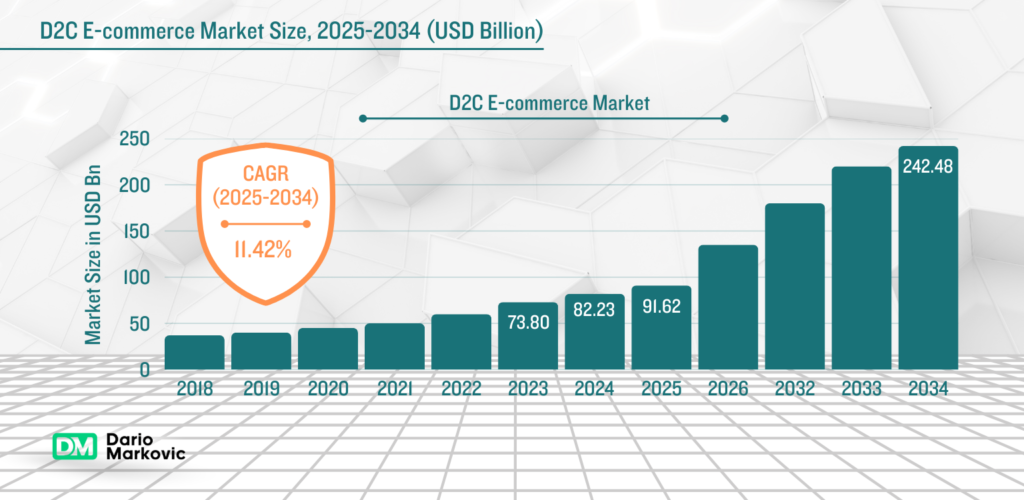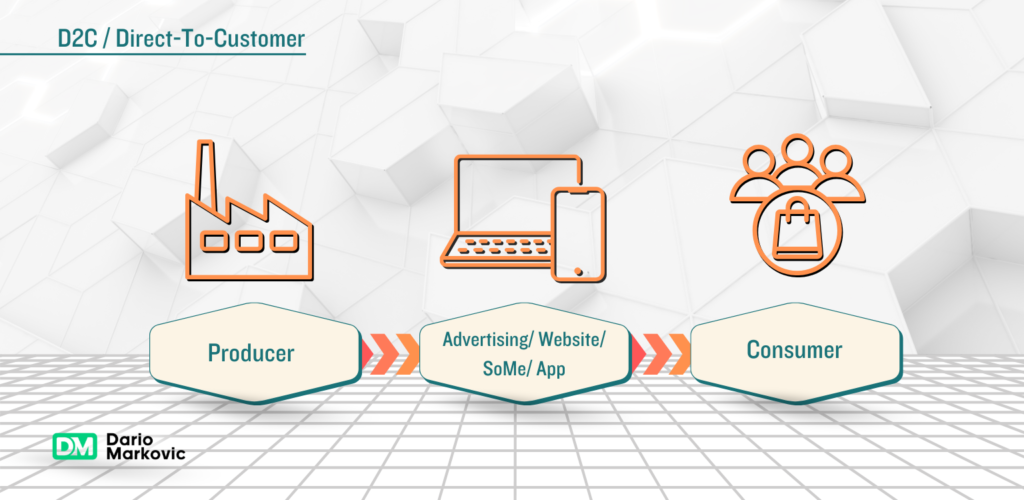The D2C market has evolved beyond a simple sales channel; it’s now a growth engine, projected to grow from $91.62 billion in 2025 to $242.48 billion by 2034, according Market Research Future.
As competition increases, compelling D2C brand storytelling is no longer a nice-to-have, it’s a must-have for brands looking to dominate their space.
Building a strong brand identity is fundamental to achieving success in the D2C marketplace. A well-defined brand identity not only distinguishes a brand in a crowded market but also fosters emotional connections with consumers, enhancing trust and recognition through consistent communication and interactions.
In this article, you’ll learn about the top 5 best D2C brand storytelling strategies to engage your customers in 2025.

What is the D2C Business Model?
D2C sales is a business model where brands sell directly to customers without intermediaries like retailers or wholesalers.

This approach provides greater control over branding, pricing, and customer experience, allowing for a more personalized and engaging connection with consumers.
Key Advantages of D2C Sales
- Increased Profitability: Eliminating retail middlemen reduces costs and maximizes profitability.
- Branding Control: D2C brands have full control over messaging, pricing, and customer interactions.
- Stronger Customer Relationship: Brands can directly collect and analyze customer data to personalize experiences and increase loyalty.
Challenges of D2C Sales
- Customer Acquisition Costs: Brands must invest heavily in digital marketing to attract new customers.
- Intense Competition: With more D2C brands entering the space, differentiation is critical.
Understanding these benefits and challenges is critical for any D2C brand looking to succeed in today’s ever-changing marketplace.
As these businesses continue to hone e-commerce funding strategies, it’s understanding the intricacies of the direct to consumer model that will help them achieve extraordinary success.
To learn more about all ecommerce models read this: 12 E-Commerce Models For Your Ecommerce Business in 2025
Why Storytelling Matters in D2C?
Traditional marketing focuses on features and price, but D2C storytelling creates deeper emotional connections that drive engagement and conversions.
Here’s why it’s essential:
- Enhances Emotional Connection through values: Customers connect with authentic brand stories aligned with their values.
- Differentiates in a Crowded Market: Unique narratives set brands apart and make them memorable.
- Builds Trust and Credibility: Transparency about mission, challenges, and impact fosters trust.
- Strengthens Community and Advocacy: Customers who resonate with a brand story become vocal advocates.
- Boosts Conversions and Retention: A compelling brand narrative turns products into experiences, increasing sales and repeat purchases.
5 Best D2C Brand Storyteling Strategies

1. Authenticity and Transparency
In a marketplace where authenticity and honesty are in high demand, real brand stories are gaining unprecedented credibility.
Authenticity builds relatability, allowing consumers to connect with a brand on a deeper level and feel that they are actually part of something real.
One great example is Eric Javits, a luxury hats and bags company that has made a long-term commitment to straw materials that were durable and serviceable. The company named it Squishee.
Their campaigns have succeeded in drawing attention to their transparent practices and ethical manufacturing, all through compelling storytelling that moves people to action.
Prioritize Authenticity: Eric Javits efforts aren’t just clever marketing; they’re part of the brand’s DNA. Customers can connect with the company because they feel like they’re part of something bigger than themselves. This authenticity builds customer relationships and drives brand advocacy in a way that nothing else can.
Leverage Digital Engagement: These strategies can be used in your own D2C approach to amplify your brand’s story and make it more compelling and effective for today’s savvy consumers.

2. Digital Engagement Strategies for Enhanced Storytelling
D2C brands can leverage digital platforms to enhance their storytelling impact. Social media platforms like Instagram and TikTok are great resources for connecting with your audience.
Here’s how to maximize your storytelling potential through these effective channels:
Create Engaging Content
Develop visually appealing and highly relatable content that resonates with your target audience. Short videos, eye-catching graphics, and authentic posts are sure to grab immediate attention. Remember to weave storytelling elements into every piece of content, highlighting your brand’s values and mission in a way that sparks real connections.
Leverage User-Generated Content (UGC)
Ask customers to share their experiences with your product. UGC is a powerful tool for building a community around your brand, as it builds trust and creates a sense of belonging. Featuring customer experiences across all your platforms will help create an emotional connection that makes customers feel heard and valued in a way they never have before.
Start a Dialogue
Don’t just create content, engage with your audience. Respond to comments, ask questions, and foster real conversations. Two-way engagement builds deeper loyalty and gives you unparalleled access to consumer needs and wants.
By embracing these digital engagement strategies, you’ll amplify your brand story and connect deeper with your audience in the competitive landscape of 2025.
3. Personalizing the Customer Journey Through Storytelling
Creating personalized customer experiences is a key strategy for increasing engagement with brand stories. Personalization helps build connections that are deeply relatable to consumers, making them feel like they are understood and valued in a unique way.
Key Strategies for Personalization
1. Data Collection in D2C
Collecting customer data is an essential part of gaining valuable customer insights into preferences and behavior at a deeper level. This information serves as the foundation for storytelling elements that are perfectly tailored to each individual’s interests and needs.
2. Segmenting Audiences
Segment your audiences based on demographics, purchase history, and online behavior. This way, you can craft narratives that resonate with specific groups, rather than a generic audience. You want your stories to feel relevant and engaging, not like a one-size-fits-all approach.
3. Dynamic Content
Use adaptive content that changes based on user interactions. For example, you can send personalized emails with product recommendations or special offers to elevate the customer experience and boost engagement.
Building Customer Loyalty
1. Tailored Communication
Share messages addressing customers’ personal experiences. Sending follow-up messages after a purchase or sharing content that aligns with their specific interests can deepen the relationship between the customer and your brand.
2. User Data-driven Storytelling
Use collected data to craft compelling stories about your brand that resonate with your customers. When customers see themselves in your narrative, they are much more likely to be loyal to your brand.
Implementing these strategies will provide a more engaging narrative experience for your customers, creating lasting relationships with your brand that benefits long-term success.
4. Influencer Partnerships as a Storytelling Tool for D2C Brands
Influencer marketing has become a powerful tool for D2C brands looking to build their brand story. Partnering with influencers can exponentially increase your reach and create content that resonates with your target customers.
The direct to consumer model benefits significantly from these influencer collaborations, as they enhance brand loyalty and customer relationships through personalized storytelling.
Here’s why influencer partnerships are becoming the new storytelling strategy:
Enhance Your Brand Story
Influencers have built strong relationships with their audiences. Their unfiltered storytelling can make your brand’s message more authentic and trustworthy than any advertisement.
Build Trust with Your Consumers
Studies show that consumers trust product recommendations from influencers more than traditional ads. This trust leads to increased engagement and dramatically higher conversion rates.
If you’re looking to collaborate with influencers, here are some tips to ensure your efforts have the greatest impact:
- Brand Values & Authenticity: Partner with influencers who embody the same values as your ecommerce brand. When these values align, authenticity of messaging is immediate and easily recognizable.
- Engagement-Rate Over Follower Count: Seek out influencers that have a high engagement rate rather than just a high follower count. Authenticity in messaging is more likely to lead to engaging storytelling, and thus, better results.
- Creative Freedom: Empower influencers to represent your product in ways that feel natural to their audience. Authenticity is more powerful than scripted dialogue, and can strengthen consumer connections that scripted content can’t.
By strategically leveraging influencer partnerships, your D2C brand can create powerful narratives that resonate deeply with consumers and build lasting trust in today’s digital marketplace.
5. Implementing an Omnichannel Approach to Support Your Brand Stories Across Touchpoints
An omnichannel marketing approach has become a key strategy for D2C brands looking to offer seamless and engaging experiences for their customers by bypassing traditional retail channels.
Combining online and offline touchpoints allows consumers to interact with your brand story across various channels, creating a holistic experience that fosters loyalty.
This is why it matters:
Improved Customer Experience
Customers can jump between your website, social platforms, and brick-and-mortar stores without any issues. This ensures that they can easily continue to engage with the rest of your brand story, no matter which step of the process they are in.
Higher Engagement
By providing the same message across different channels, you’re more able to reinforce your brand than ever before. This helps to deepen the emotional connection the customer has with the story you are trying to sell, turning casual browsers into brand ambassadors.
Mobile Optimization
With the majority of consumers accessing content through mobile devices, the optimal mobile optimization strategy is no longer optional – it’s mandatory. A responsive design ensures that your story reaches the audience, regardless of device. A seamless mobile experience empowers users to delve deeper into your brand and become more intimate with your narrative.
Investing in these areas not only improves customer satisfaction, it also gives you the seamless experience that today’s consumer expects, as detailed in the Ultimate Guide to Best D2C Brand Storytelling Strategies in 2025.
Using Data to Enhance Brand Storytelling
In the D2C space, companies must optimize their storytelling strategies.
One way to do this is learning to use analytics tools. These allow you to tap into limitless insights about how your customers are interacting with your brand stories, and why they make the choices they do.
Gathering Insights
Using advanced analytics tools, you can trace engagement rates across channels and platforms. With this, you can determine which stories resonate most with consumers, and tailor your messaging to better match their preferences and build stronger connections.
Refining Narratives
Pay attention to common themes and sentiments in customer feedback. Determine what truly delights your customers and use it to create more relevant narratives over time. For example, if sustainability is a major draw for your customers, make sustainability-focused branding a priority.
Armed with these insights, you’ll have the ability to build a flexible story that can change with consumer expectations, keeping you and your brand relevant and impactful in the extremely competitive world of D2C, where only the most agile brands will make it.
Building a Community Around Your Brand Story
In today’s world, a strong sense of belonging has never been more important. Customers want to connect with brands that speak their language and tell their stories.
By creating a strong sense of community in D2C, you can engage consumers in meaningful ways that amplifies loyalty and repeat business.
Building a strong brand identity is essential for fostering this community and differentiating your brand in a crowded market.
Key Elements of Community Building
- Shared Values: If your brand’s story aligns with your audience’s beliefs or values, you have a winning combination. When your customer feels you are “one of them”, they feel no reason to question your intentions and will be willing to stand by you unconditionally. The relationship between your product, your brand and your customers will become unbreakable and they will become loyal brand ambassadors. The customers who buy your product just because they “need it” will become “brand lovers” and will be happy to share their experiences with others whenever they feel the need.
- Engagement Initiatives: Always try to engage your customers and encourage them to take part in your campaigns. Ask them to share their experiences with your product. Use user-generated content as a means to showcase your brand in action. User-generated content has the power to not only bring your brand closer to your audience, but also to make them a part of your community.
Examples of Successful Initiatives
- Eric Javits: The brand is all about straw material and wants you to share your lightweight hats. The community engagement is unprecedented and the brand has become a trusted partner with those who buy their products.
- Glossier: Glossier leverages social media in the most innovative ways. They have a shared beauty story that is personal and authentic. Customers feel special because they are a part of the story. They have an extraordinary engagement rate and everyone is a repeat buyer.
One of the most effective investments you can make is in building a community.
Emotional connections with customers cannot be replicated with other methods.
They lead brand D2C to sustainable growth and long-term loyalty if they will build authentic relationships with their customers instead of transactional interactions.
SEO-Optimized Content Marketing Strategies for Storytelling
Acquiring the right potential customers that align with your brand story is a key aspect of content marketing for D2C brands.
Implementing robust SEO methods ensures your stories are found in a crowded digital world, amplifying the effectiveness of your content marketing and improving search engine visibility.
Core Elements of SEO Strategies:
- Keyword Research: Identify powerful keywords that connect to your brand story. Use tools like Google Keyword Planner to discover terms that align perfectly with audience interests and search patterns.
- On-Page Optimization: Incorporate targeted keywords naturally within headings, subheadings and body text. Optimize meta descriptions and image alt tags to further enhance searchability and drive relevant traffic.
- Quality Content Creation: Develop content that resonates with your target audience while maintaining SEO best practices. Compelling stories and relevant content can increase organic traffic, as users spend more time on your website and explore related pages.
Benefits of SEO in Storytelling:
- Increased Visibility: An SEO-optimized website appears at the top of search results, allowing you to capture the attention of more potential customers who are actively looking for your product or service.
- Deeper Engagement: If your content is relevant and resonates with the right audience, you will create connections that will encourage them to look deeper into your brand and convert at a higher rate.
If you use these strategies you can amplify your brand stories and ensure they are seen by the right audience in the right place at the right time, turning window shoppers into customers.
Dario’s Conclusion
Embrace new story telling methods to connect with your audience authentically through powerful storytelling techniques across today’s changing channels.
The key D2C storytelling takeaways are:
- Personalization: It can elevate customer engagement strategies by 200%
- Digital storytelling: It can deliver more impactful, deeper-level storytelling
- Community-building: It can help to build a living, breathing community around your brand
By incorporating these best practices, you can become an industry leader rather than simply a product vendor.
Engage with your consumers on a deeper level, and watch your brand flourish in 2025 and beyond.
FAQs
Why is brand storytelling vital in the D2C model?
Brand storytelling helps differentiate brands, build trust, and foster emotional connections, driving higher engagement and loyalty.
Which platforms are best for D2C brand storytelling?
Social media (Instagram, TikTok, LinkedIn), video content, email marketing, and owned websites are essential for effective storytelling.
How can D2C brands personalize storytelling?
Brands can use data-driven insights to segment audiences and tailor messaging based on customer preferences and behavior.
What role do influencers play in storytelling?
Influencers add authenticity and expand reach by sharing relatable, engaging narratives that resonate with target audiences.
How can analytics improve storytelling?
Tracking engagement, conversions, and customer sentiment helps refine narratives and optimize storytelling for maximum impact.



